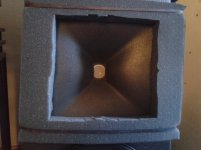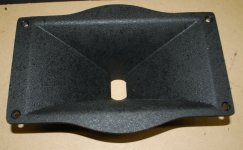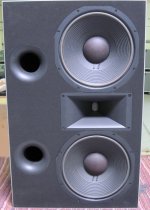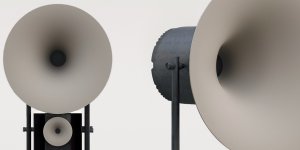Is it ok to paint it to make it look more presentable?
I think so, but as it turns out, the junctures in the horn do not affect performance.
Ah OK !
I quess this waveguide does still behave better than an old 2344 for instance. Or am I wrong ?
I concluded that I prefer older JBL horn to newer JBL waveguide, after careful comparison for 2 years. I would say it's all about the personal taste. 🙂
Cut-off frequency for JBL STX825 horn (p/n 5006815)?
My gut feeling tells me that sharper shapes used for diffraction work better up to higher frequencies in achieving wide dispersion but smoother ones have less unwanted side effects (like uneven frequency resonse and horn honk).
Regards
Charles
Apart from the shape of the slot (sharp/smooth edged or bubble-like) it's the location of the slot (along the z-axis) that determines its impact on the response.
Nearly all JBL horns, from the bi-radial days up to now, are a combination of a slot near the throat and 'bubbles' towards the mouth, in the vertical, horizontal or both walls. The M2 waveguide can be considered as the culmination of decades of R&D.
Last edited:
I assume the further back the slot is, the better in terms of resonances etc, right ?
Just watch out that it doesn't sound coloured afterwards ! 😉
Fun aside: As Long as your painting isn't too thick it shouldn't matter.
Regards
Charles
Is it ok to paint it to make it look more presentable?
Just watch out that it doesn't sound coloured afterwards ! 😉
Fun aside: As Long as your painting isn't too thick it shouldn't matter.
Regards
Charles
I assume the further back the slot is, the better in terms of resonances etc, right ?
In general yes, but the physics of diffraction slots is very complicated.
I have yet to find research that's all encompassing in this respect.
Most research is done using BEM/FEM, because as far as I know, there is no such thing as a unified mathematical theory of diffraction slots.
Last edited:
There's a white rim visible in the upper section of the throat. Is the driver properly aligned?
I think so, but as it turns out, the junctures in the horn do not affect performance.
Visual psychoacoustics do play a role though! 🙂 (WAF role too!)
I like “coloured” sound hehehe
I assume the further back the slot is, the better in terms of resonances etc, right ?
Just watch out that it doesn't sound coloured afterwards ! 😉
Fun aside: As Long as your painting isn't too thick it shouldn't matter.
Regards
Charles
Hehehehe!
Ill dip it in one coat of snake oil heheh
One of JBL's most elegant horns:
Attachments
Last edited:
If you reduce the throat size from 1.5 to 1", increase the vertical coverage angle by about 10-20° and add roundovers, you'll end up with something like this:
An externally hosted image should be here but it was not working when we last tested it.
Last edited:
Hmm, maybe not.
Stock from factory.
Great, another thing to do..........
Adding 1 - 1.5lbs of acousta stuff helped the mids in the jbl.
Stock from factory.
Great, another thing to do..........
Adding 1 - 1.5lbs of acousta stuff helped the mids in the jbl.
It looks different, but (basically) the same horn was used for the DMS-1.
In combination with modern loudspeaker management, this is still a sota studio monitor.
In combination with modern loudspeaker management, this is still a sota studio monitor.
Attachments
Last edited:
This is probably the thread with measurements that was mentioned before by member plasnu.
Last edited:
Here is a TAD studio monitor that was for sale.
TAD Studio Monitors Speakers For Sale - UK Audio Mart
TAD Studio Monitors Speakers For Sale - UK Audio Mart
Is it ok to paint it to make it look more presentable?
Sure! Though according to Boeing it needs a < 400 micro-inches finish for best performance, i.e. essentially hydraulically smooth or in the vernacular, 'smooth as a baby girl's bottom' 😉.
Some of the molded horns I've seen were smooth enough to only need a good wax job with the most aerodynamic DIY paint jobs I've seen were either dipped or had a lot of hours of [meticulous] hand rubbing.
GM
- Home
- Loudspeakers
- Multi-Way
- Is it possible to cover the whole spectrum, high SPL, low distortion with a 2-way?




